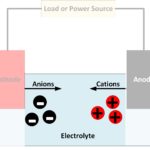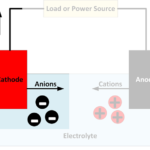A group of researchers hailing from Nanyang Technological University in Singapore have devised stretchable silver electrodes whose conductivity can be enhanced by human sweat. The stretchable electrodes were fabricated by directly printing an ink composed of conductive silver flakes and specially designed elastic binder called hydrophilic poly(urethane-acrylate) (HPUA) on hydrophilic textiles.

(A) How the surface of the printed Ag-HPUA electrodes change upon contact with sweat before and after stretching. (B) Composition and photo image of the Ag-HPUA ink. Scale bar, 2 cm. (C and D) SEM images of Ag-HPUA electrode before and after soaking with sweat, respectively. Scale bars, 1 μm. Illustrations of fabrication Ag-HPUA electrodes on the textile by screen printing (E) and direct writing (F), respectively. (G and H) Screen-printed and direct-writing patterns on the textile,
respectively. Scale bars, 2 cm. Photo: Jian Lv, Nanyang Technological University. Click image to enlarge.
Researchers say the HPUA elastic binder has a high stretchability and good hydrophilicity thanks to the presence of rationally controlled hard-soft domains and the existence of urethane-acrylate (C═C) groups, respectively. In the presence of sweat, the Cl−
and the acidic environment work synergistically to remove the surfactant of the silver flakes and make connections to adjacent flakes on printed electrodes, which can reduce the resistance of electrodes in both relaxed and stretched states. When one electrode was mounted on a subject’s arm with sweat, its resistance could be decreased from 3.02 to 0.62 ohms.
Electrode fabrication involves screen printing and direct writing on textiles and then curing at room temperature.
To illustrate the concept, researchers printed textiles with a kind of stretchable zinc battery using human sweat as the electrolyte and Ag-HPUA ( hydrophilic poly(urethane-acrylate)) electrodes as the current collector. The battery served as the wearable power source able to function under 50% strain. A printed Zn electrode served as the anode, and Ag2O served as the cathode. The porous textile substrate served as a sweat absorber and separator while also promoting the high loading of electrode inks. In the presence of human sweat, electrons get generated on the anode from Zn flakes and then transfer to the cathode through external loading to reduce Ag2O to Ag. The battery was on a subject’s forearm. The current density of the printed battery with 1-kilohm external loading went from 0 to 0.97 mA/cm2 after 16 minutes of exercise and stayed at this level afterward.
Researchers used a biodegradable and compostable polymer called Ecoflex to isolate each battery and avoiding short circuits. A 5.6-mF capacitor was used to buffer the energy generated by batteries. After the 16-minute exercise generated enough sweat, four series-connected batteries were enough to charge the capacitor to 4.17 V in 40 sec.

The printed Ag-HPUA electrode on one subject’s forearm for real-time testing. Photo: Jian Lv, Nanyang Technological University.
Researchers think their battery could prove useful in the continuous monitoring of the body temperature. Printed stretchable sweat batteries could power commercial wireless temperature sensors monitoring a person’s body temperature and sending the data to the smartphone. In that regard, they used the charge on the capacitor to power a wireless temperature sensor that connected to a smartphone and sent real-time temperature data. The average power needed in the pairing period and data sending period are less than 0.24 and 0.162 mW, respectively. The batteries can replenish the consumed energy in the capacitor in both the connecting period and data-sending period.
The researchers point out that human sweat is relatively acidic (pH 4 to 6.8) and rich in Cl− ions. When the printed electrodes encounter human sweat, the acidic environment and Cl− work together to partially remove an insulating lubricant layer and increase the contact among adjacent Ag flakes by redepositing Ag from dissolved Ag+, making the surface of the AgHPUA electrodes rougher. This effect gives the printed Ag-HPUA electrode more conductivity in both original and stretched states compared with dry sweat-free electrodes.





Tell Us What You Think!